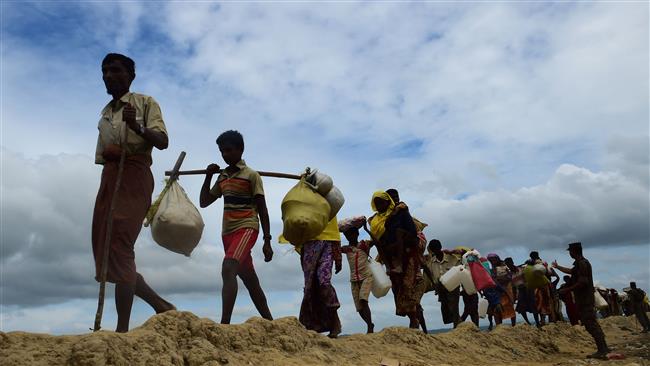
RNA - Reuters reported on Wednesday that work on the project had accelerated in recent months as a group of foreign engineers were providing assistance to the Bangladeshi government for the preparation of Bhashan Char Island — also known as Thenger Char — to receive refugees before the onset of monsoon rains in April, presstv reported.
Reports said hundreds of laborers were carrying bricks and sand from ships on its muddy Northwest shore, with satellite images also showing roads and what appeared to be a helipad.
Bhasan Char, whose name means “floating island”, emerged from the silt about 20 years ago and is located about 30 kilometers from mainland Bangladesh. The island is flat, shape-shifting, and inundated by regular floods during the months of June and September every year.
Aid workers have expressed grave concern that the silt island is vulnerable to frequent cyclones and cannot sustain the livelihood of thousands of people.
Contradictory statements
Bangladeshi Prime Minister Sheikh Hasina said in a statement earlier this week that the settlement of Rohingya Muslims on the island would be a “temporary arrangement” to reduce the dense population at the refugee camps in the Bangladeshi border city of Cox’s Bazar, where nearly 700,000 members of the ethnic minority group currently live in deteriorating humanitarian conditions.
There are many other Rohingya refugees who had resettled in Bangladesh before a recent wave of state-sponsored violence started in neighboring Myanmar in August last year.
In an interview with Reuters, an adviser to the Bangladeshi Prime Minister said, however, that the Rohingya refugees would only be able to leave the island if they wanted to go back to Myanmar or were selectively granted asylum by a third country.
“It’s not a concentration camp, but there may be some restrictions. We are not giving them a Bangladeshi passport or ID card,” H.T. Imam said, adding that the island would have a police encampment with some 50 armed personnel.
Reacting to the comments, the United Nations High Commissioner for Refugees emphasized in a statement that “any relocation plan involving refugees would need to be based on and implemented through voluntary and informed decisions.”
A plan to develop the island and use it to house refugees was first proposed in 2015 and revived last year. Despite criticism of the conditions on the island, Bangladesh said it has the right to decide where to shelter the growing numbers of refugees.
The news came as the government of Myanmar decided on Tuesday to process and resettle some 6,000 Rohingya Muslim refugees who are currently stranded at the country’s border with Bangladesh.
Bangladesh and Myanmar signed an agreement in November last year to repatriate all Rohingya Muslims who have crossed the border since August to escape a brutal military crackdown.
The repatriation was set to start last month, but was delayed by a lack of preparation, as well as protests staged by Rohingya refugees against the plan to send them back to Myanmar while conditions were not safe for their return.
Myanmar’s government troops have been committing killings, making arbitrary arrests, and carrying out arson attacks in Muslim villages in Western Rakhine State since late 2016.
The Rohingya have lived in Myanmar for generations but are denied citizenship and are branded illegal immigrants from Bangladesh, which likewise denies them citizenship.
The UN has described the 1.1-million-strong Muslim community as the most persecuted minority in the world.
Civilian witness contradicts Myanmar police on Reuters reporters’ arrest
Separately on Wednesday, the first civilian who testified at a hearing in the case of two Reuters reporters who had been covering the crackdown on the Rohingya in Myanmar and have been accused of violating Myanmar’s Official Secrets Act contradicted police and prosecutors about where the pair had been arrested.
The two local journalists, Wa Lone and Kyaw Soe Oo, were detained last December during a meeting with two police officials over dinner for allegedly “possessing important and secret government documents related to Rakhine State and security forces.”
The hearing was held as the exact location of the detentions has emerged as a point of contention in the proceedings.
The reporters told relatives that they were taken into custody almost immediately after being handed some papers at the Saung Yeik Mon restaurant by two police officers they had not met before.
This is while the prosecution and earlier police witnesses testified that the journalists were detained after they were stopped and searched on a street, which is several hundred meters from the restaurant.
At a news conference late last year, family members of the journalists said that police may have fabricated a case for their arrest.
The two reporters had been working on a Reuters investigation into the killing of 10 Rohingya Muslim men who were buried in a mass grave in Rakhine State, where Myanmar has barred foreign groups and reporters from entering.
847/940